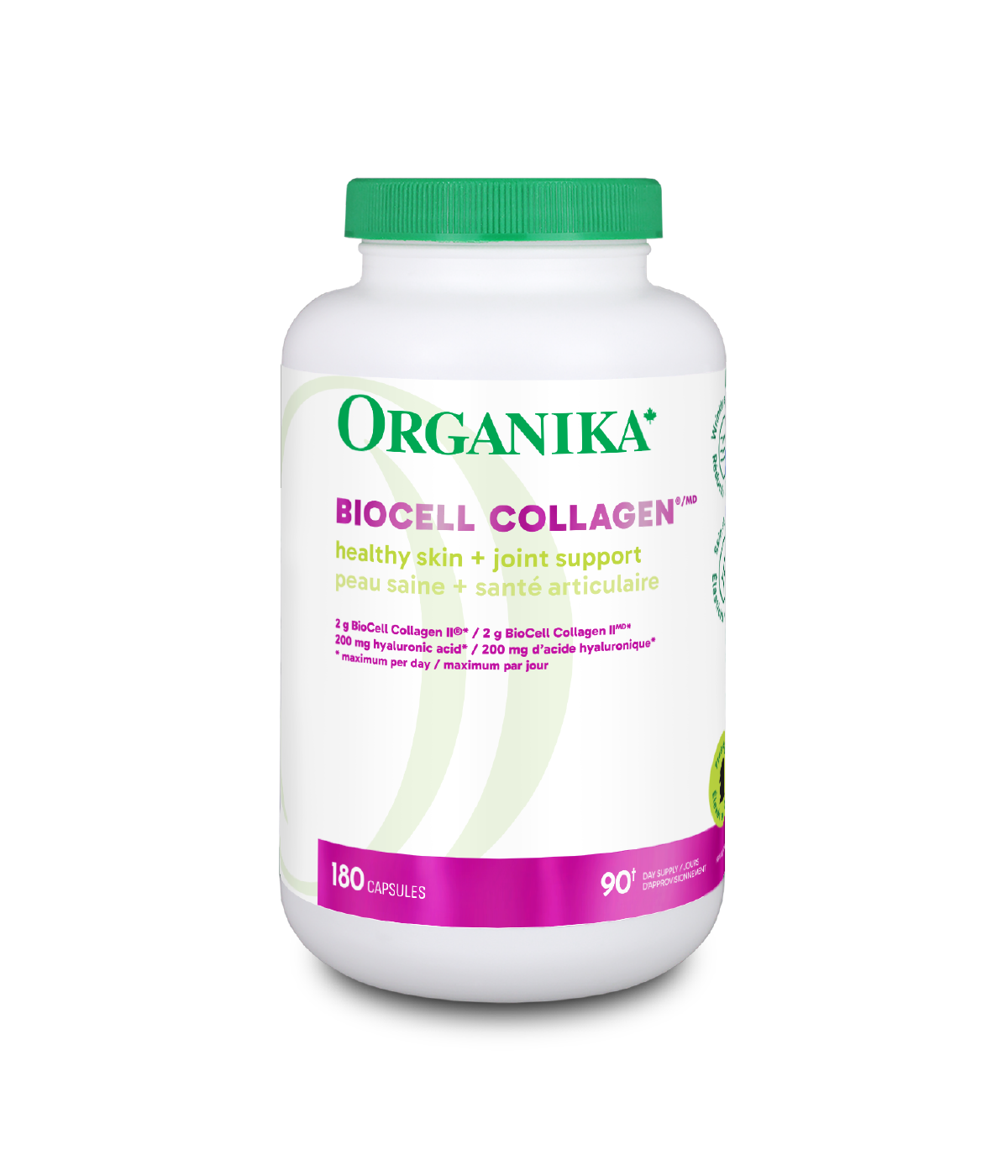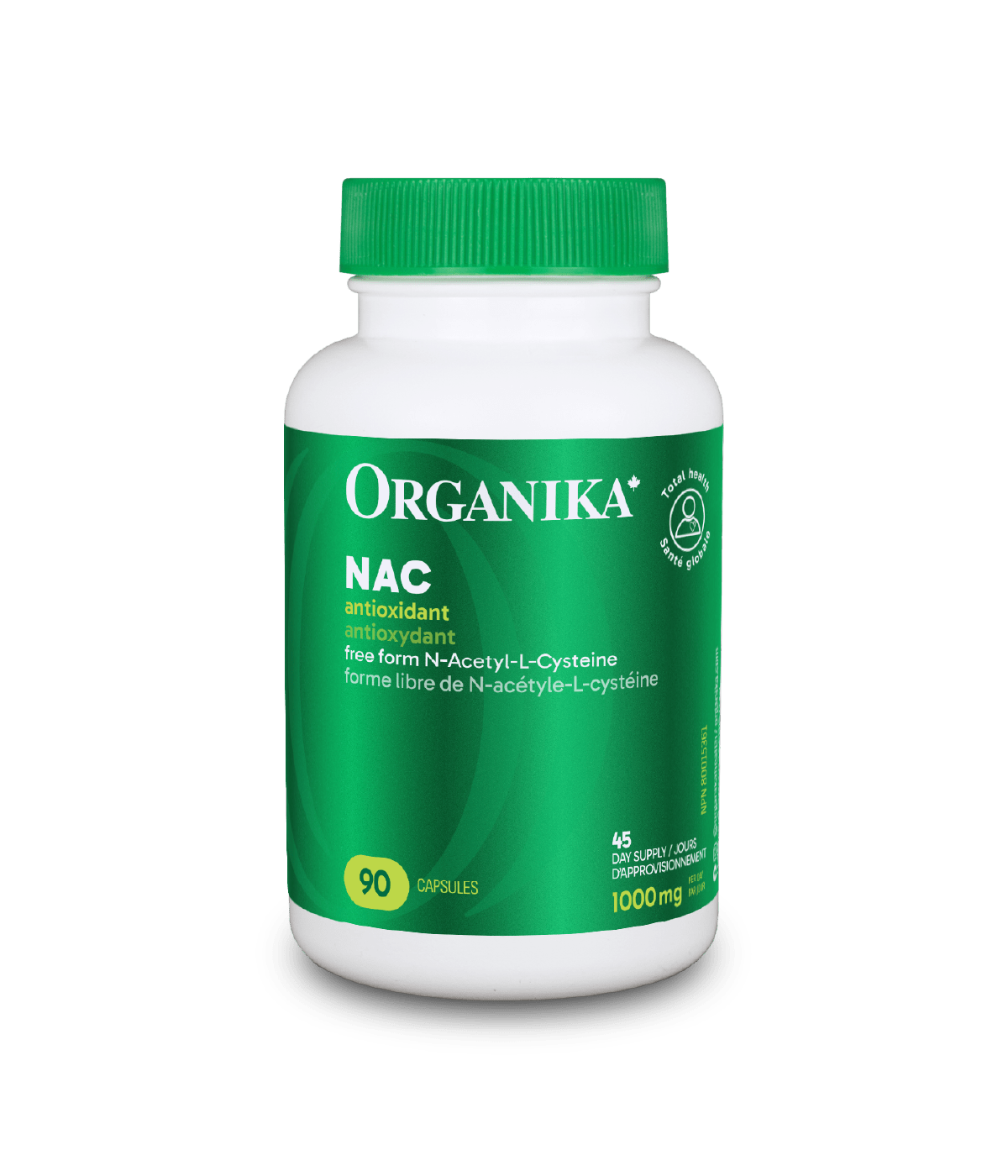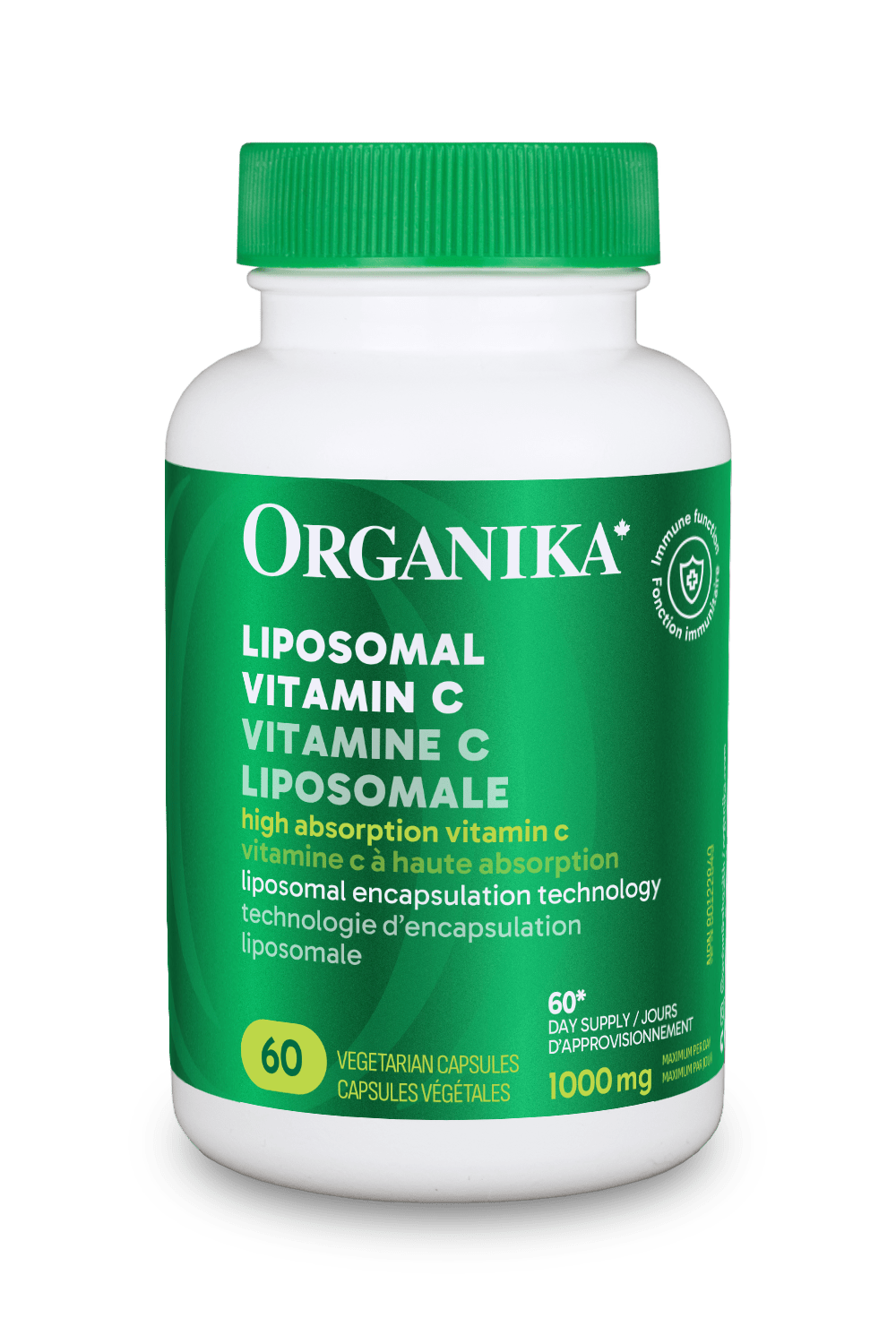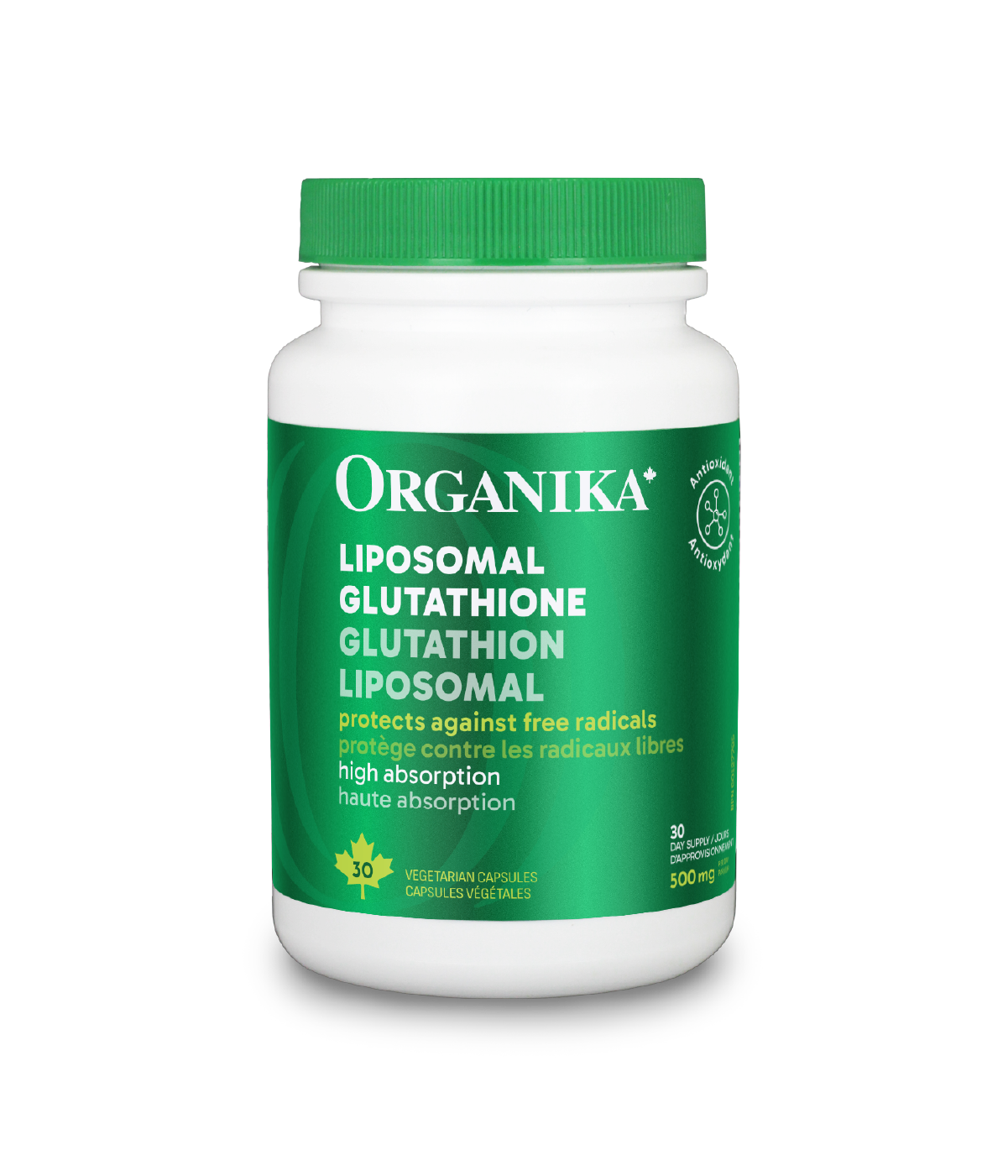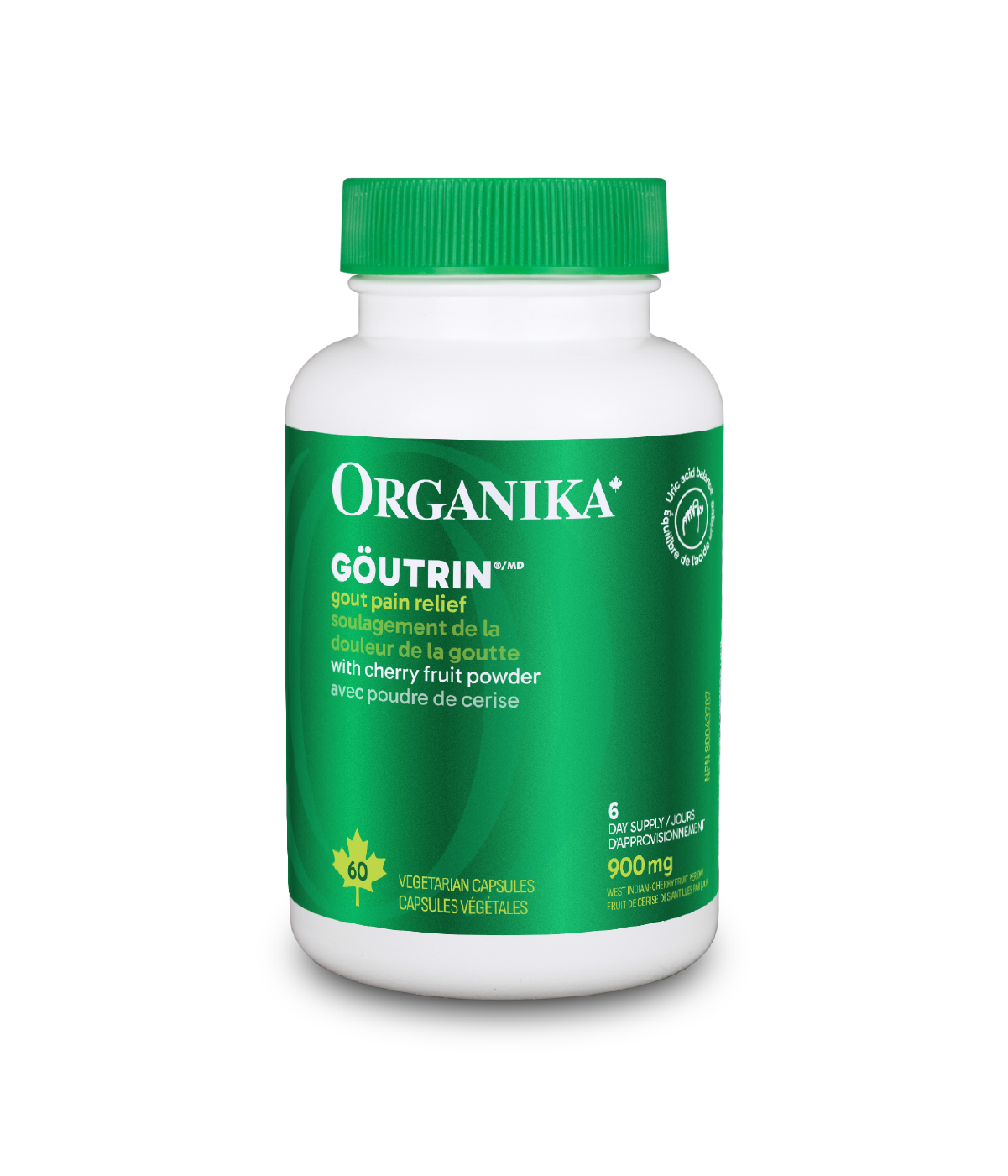
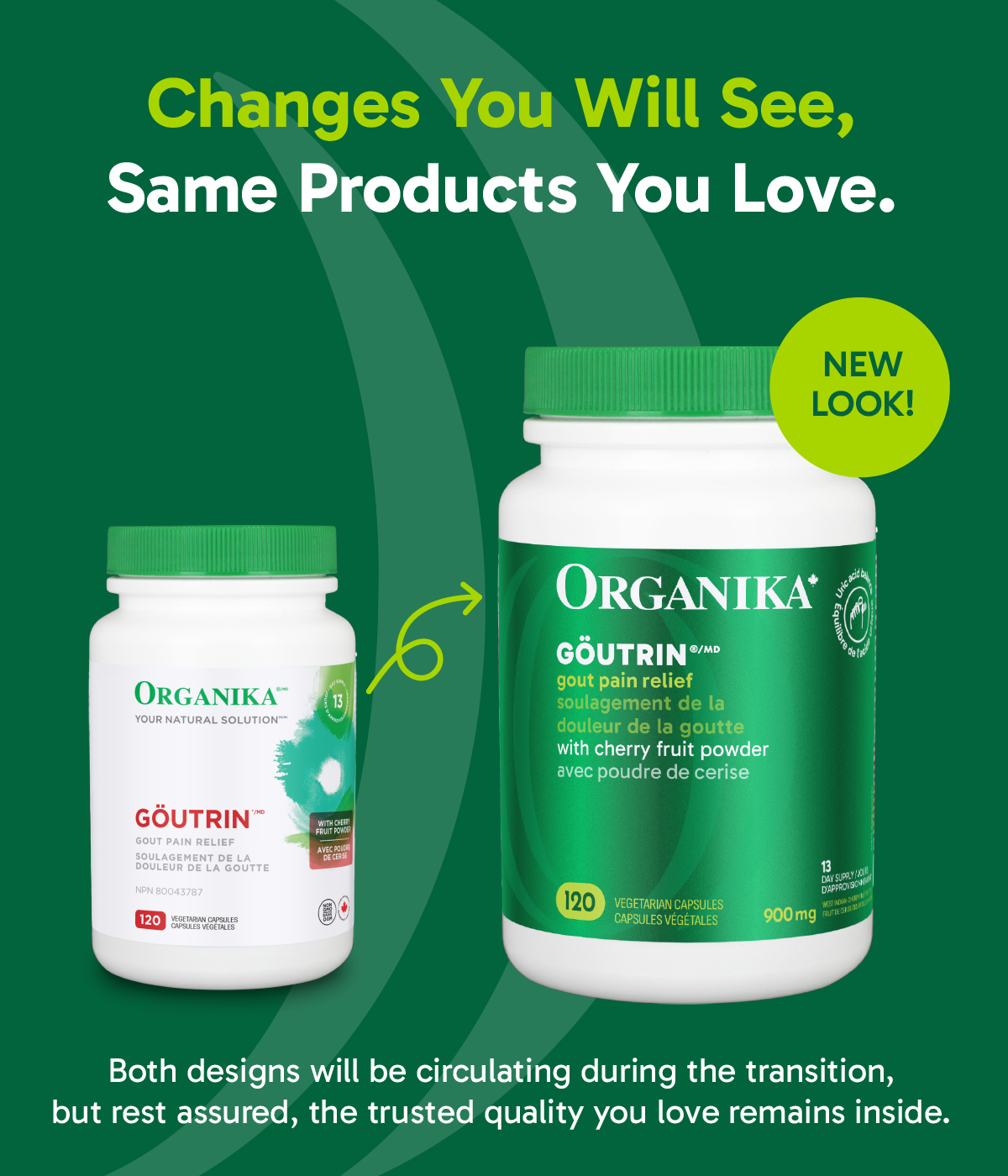
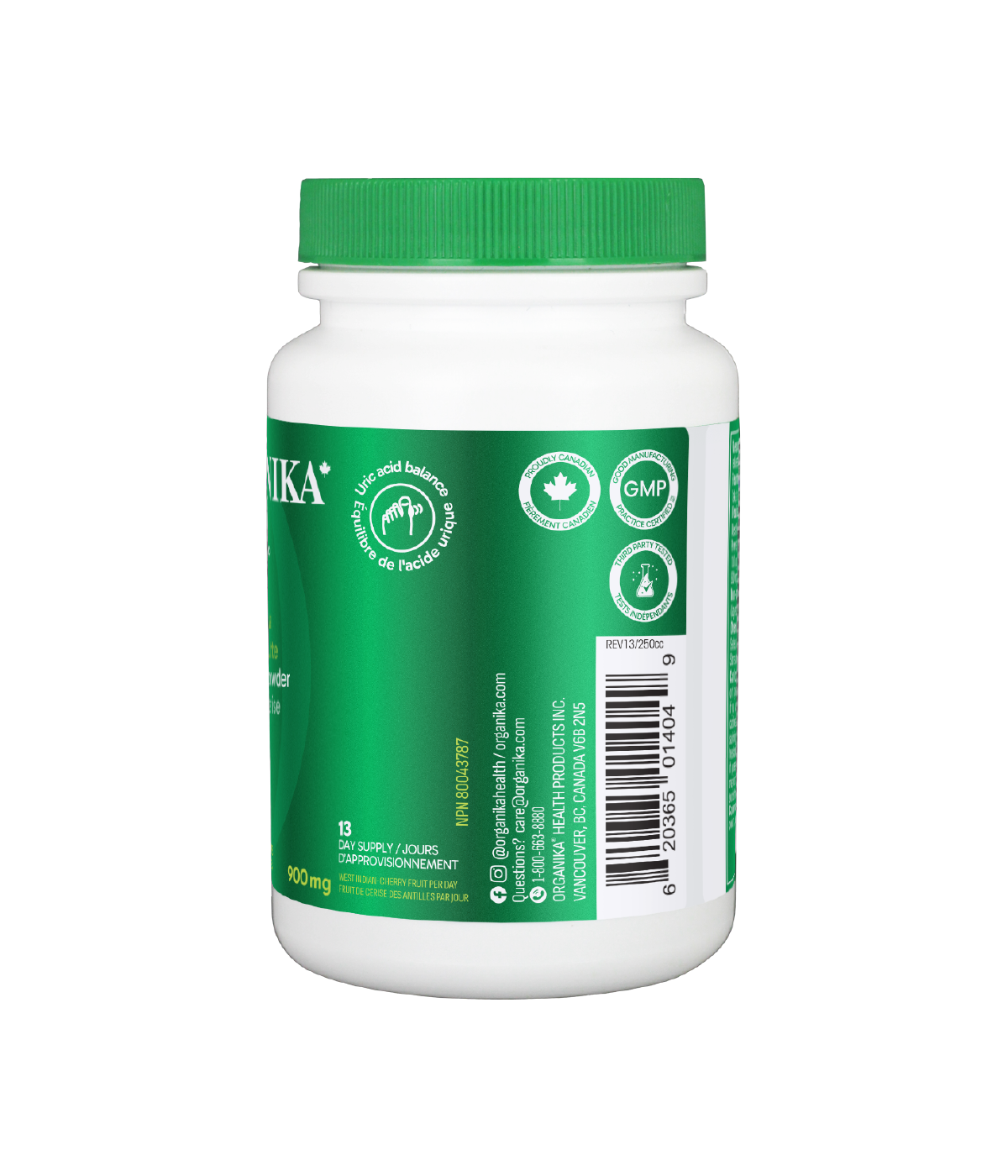
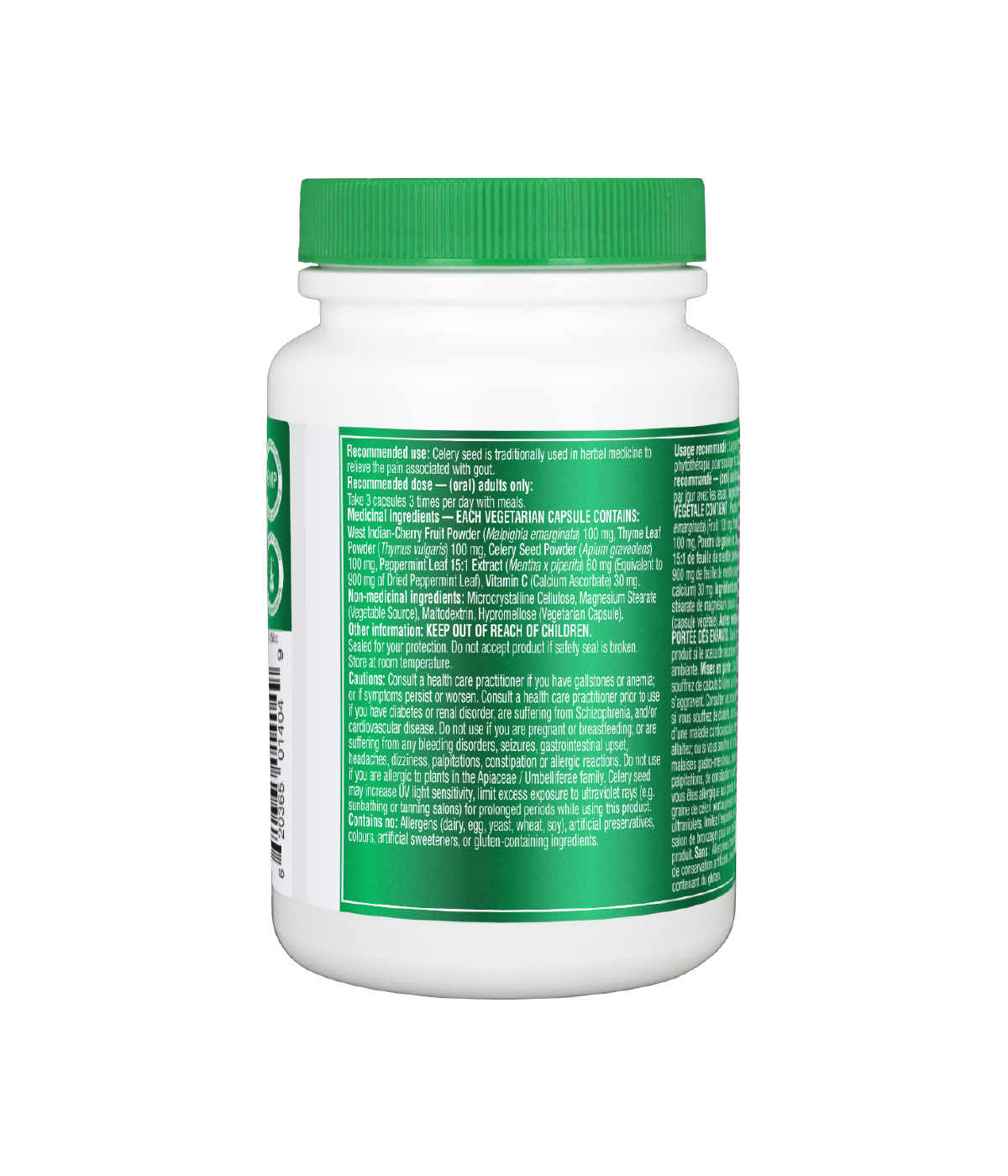
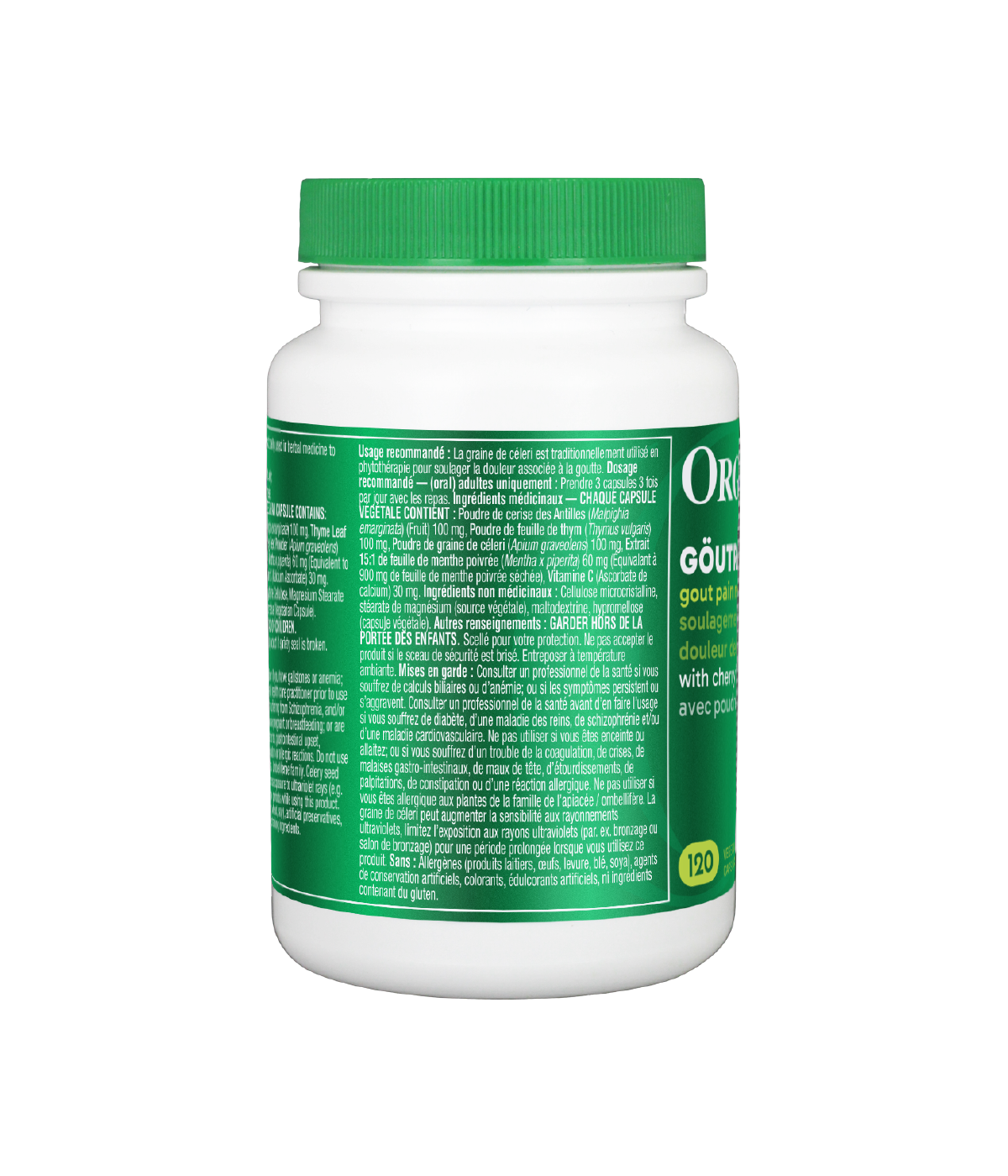

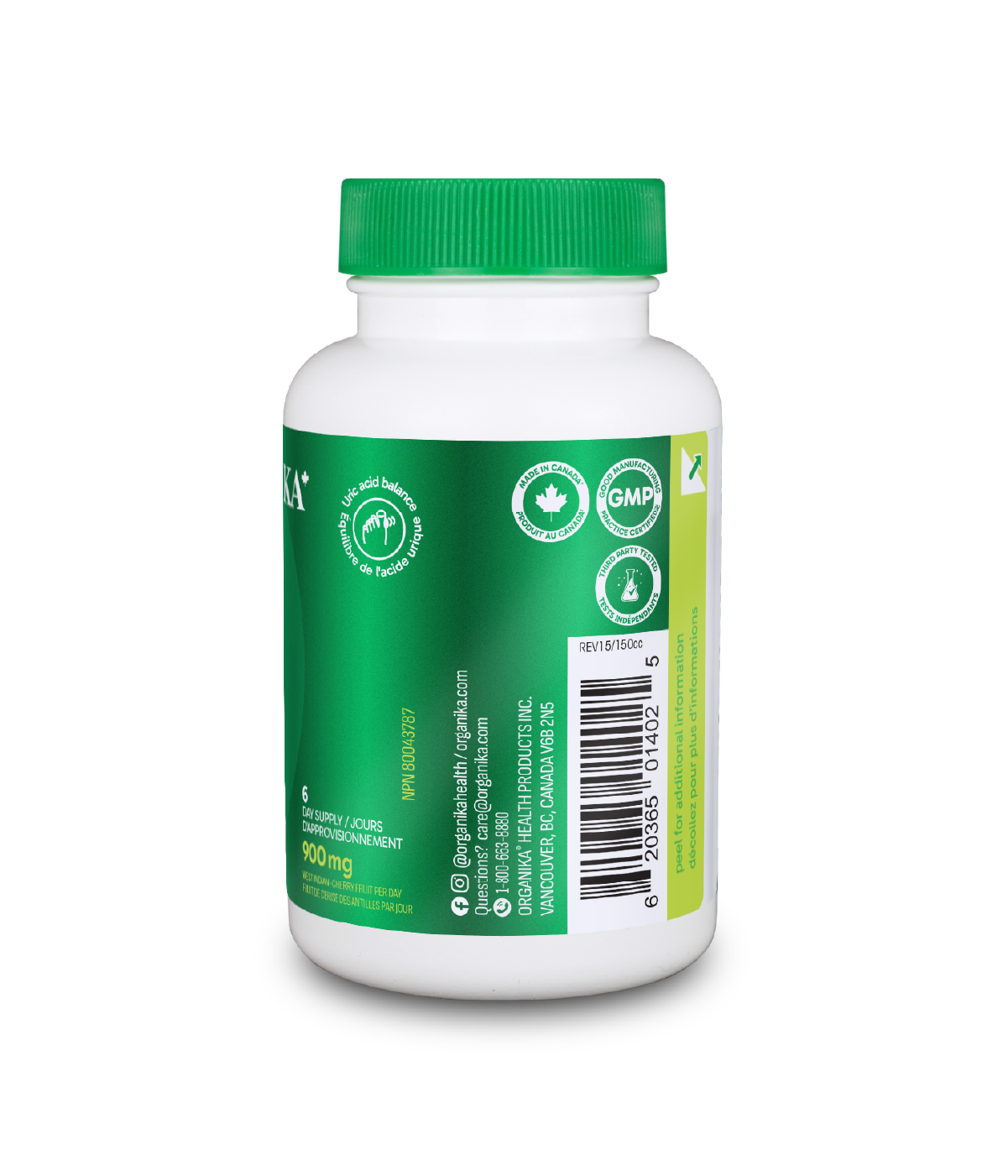
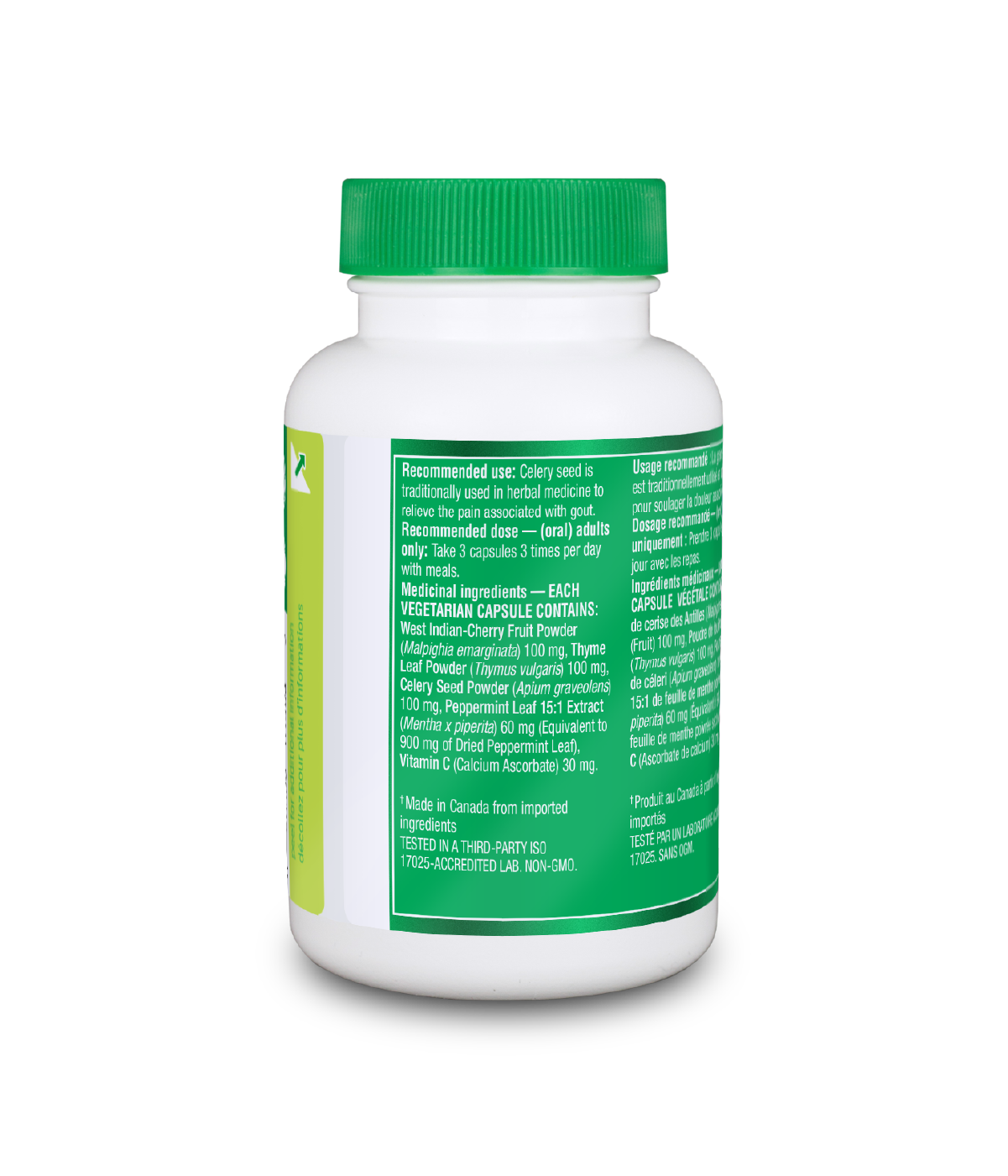
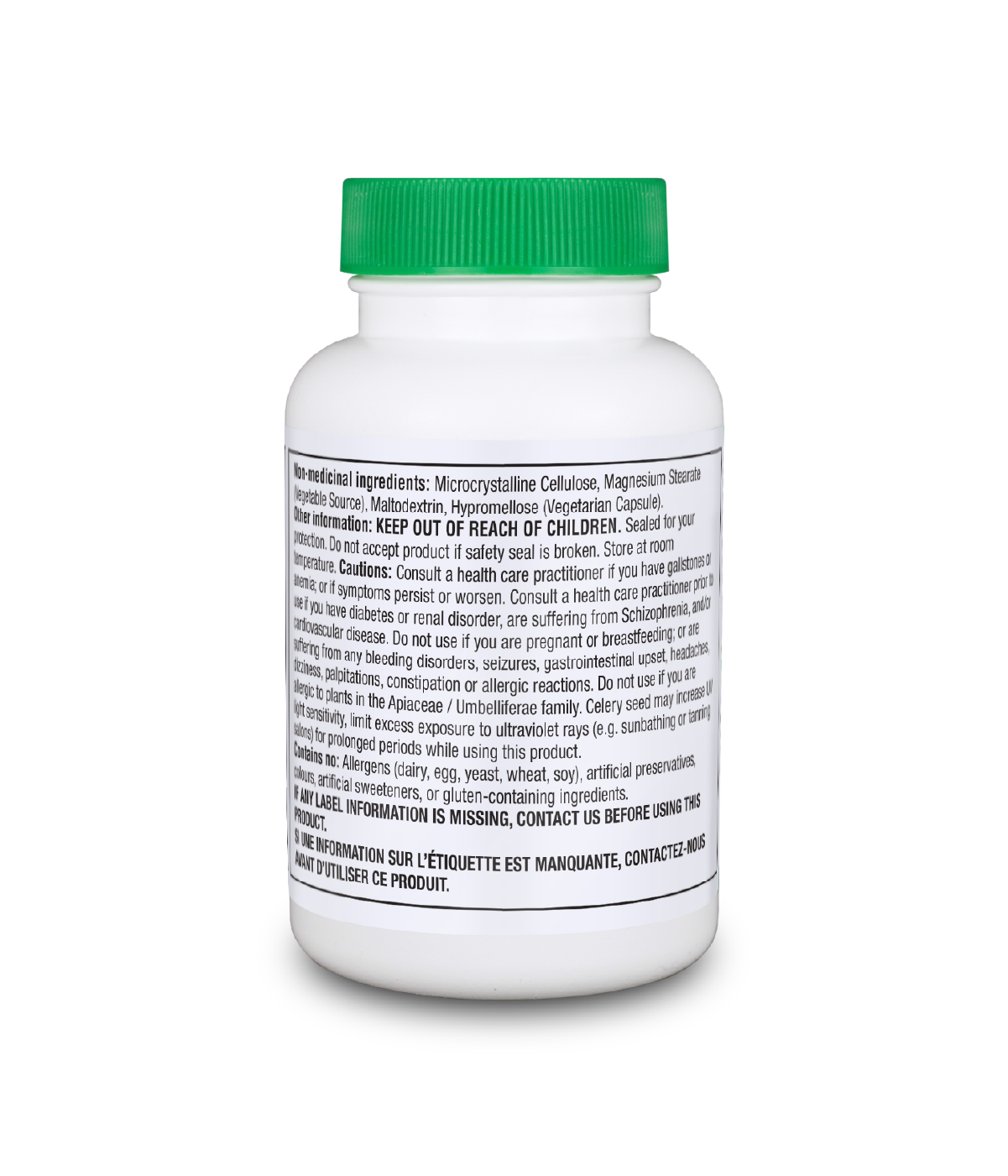





-
Is this right for you?

-


-


-

-

-

-

-

-

-

-

-

Göutrin
Tackle uric acid for gout relief and prevention
- Reduces inflammation
- Supports kidney health
- Helps lower uric acid levels
- Capsule form for ease-of-use
Couldn't load pickup availability



Notify Me When Available
Enter your email and we'll let you know as soon as this product is back
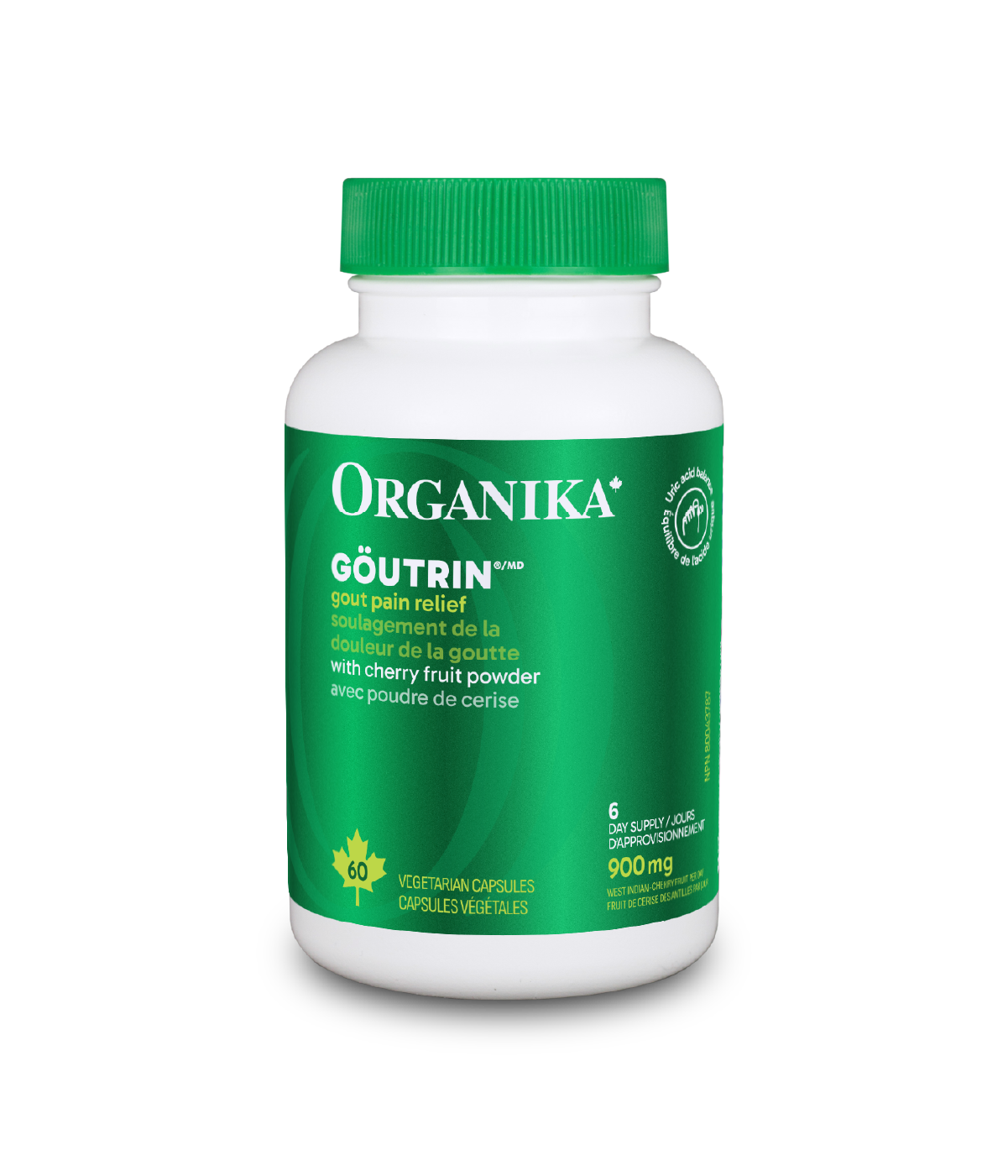
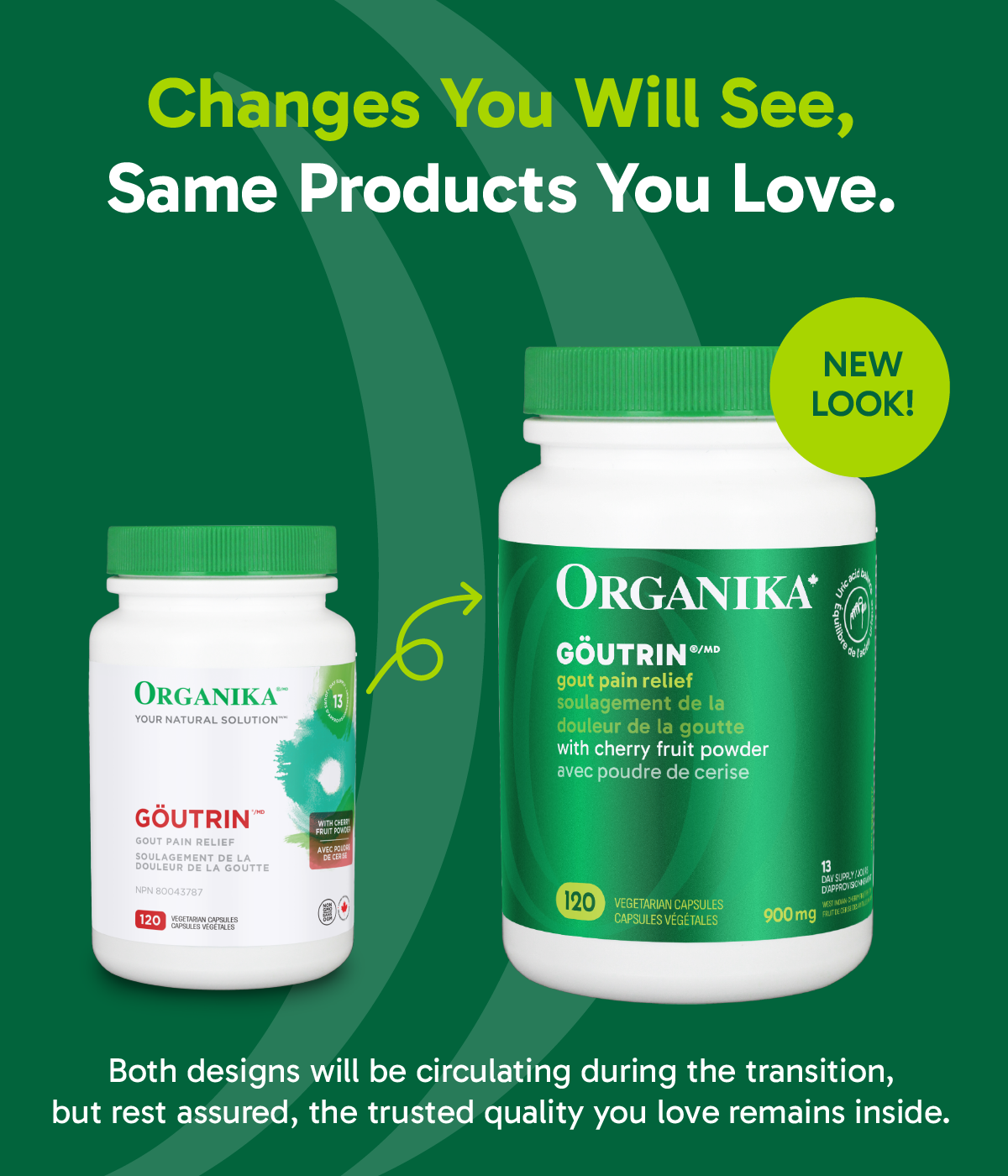
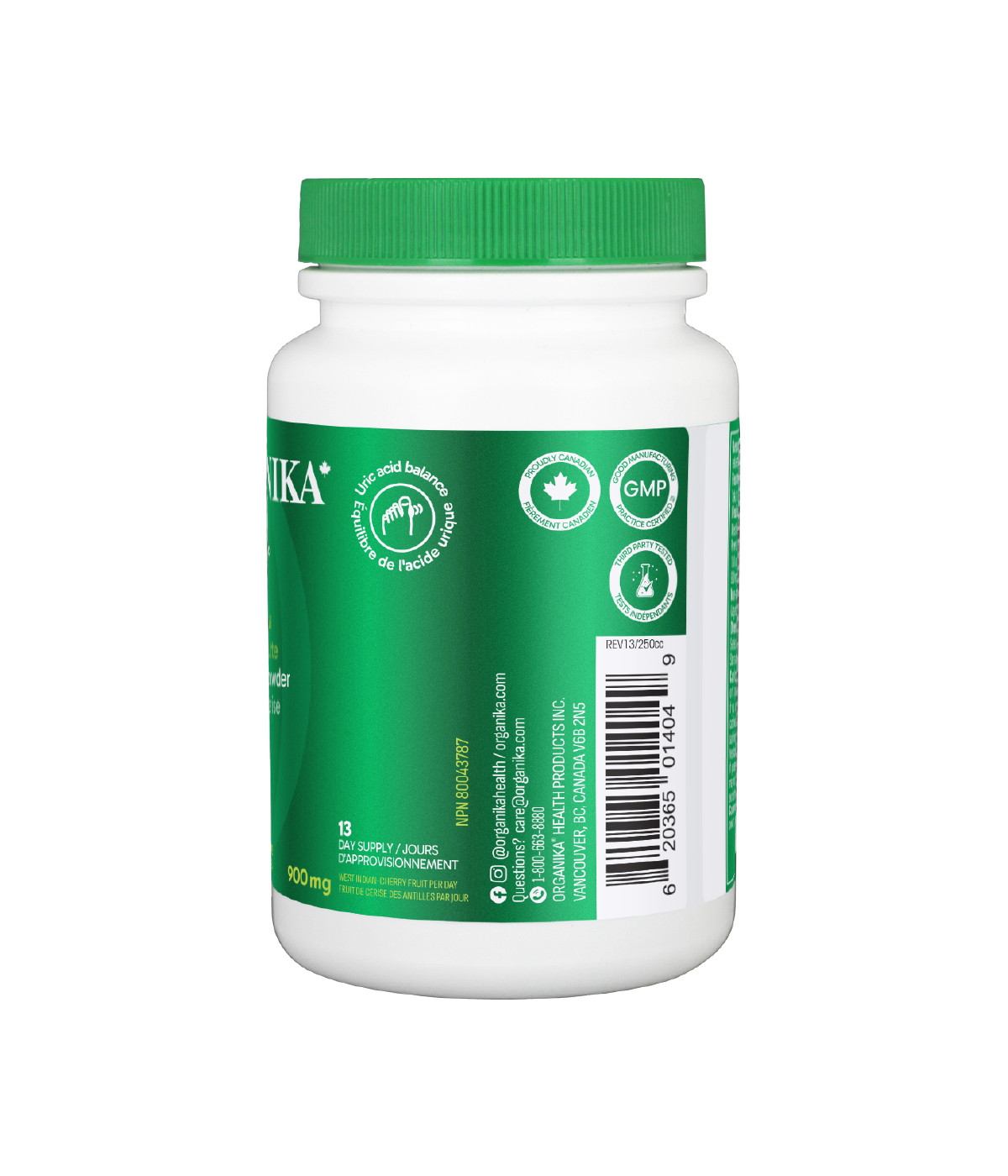
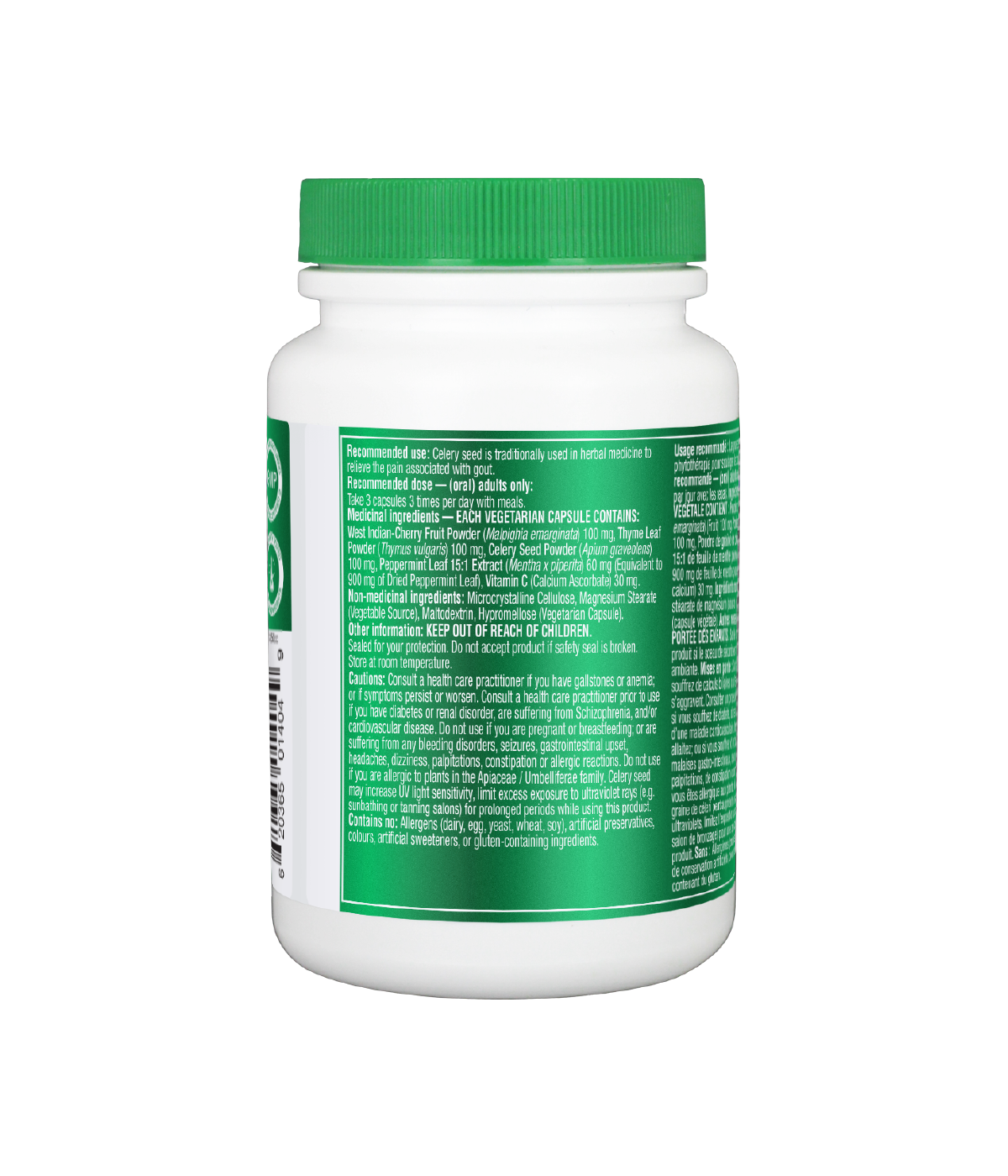
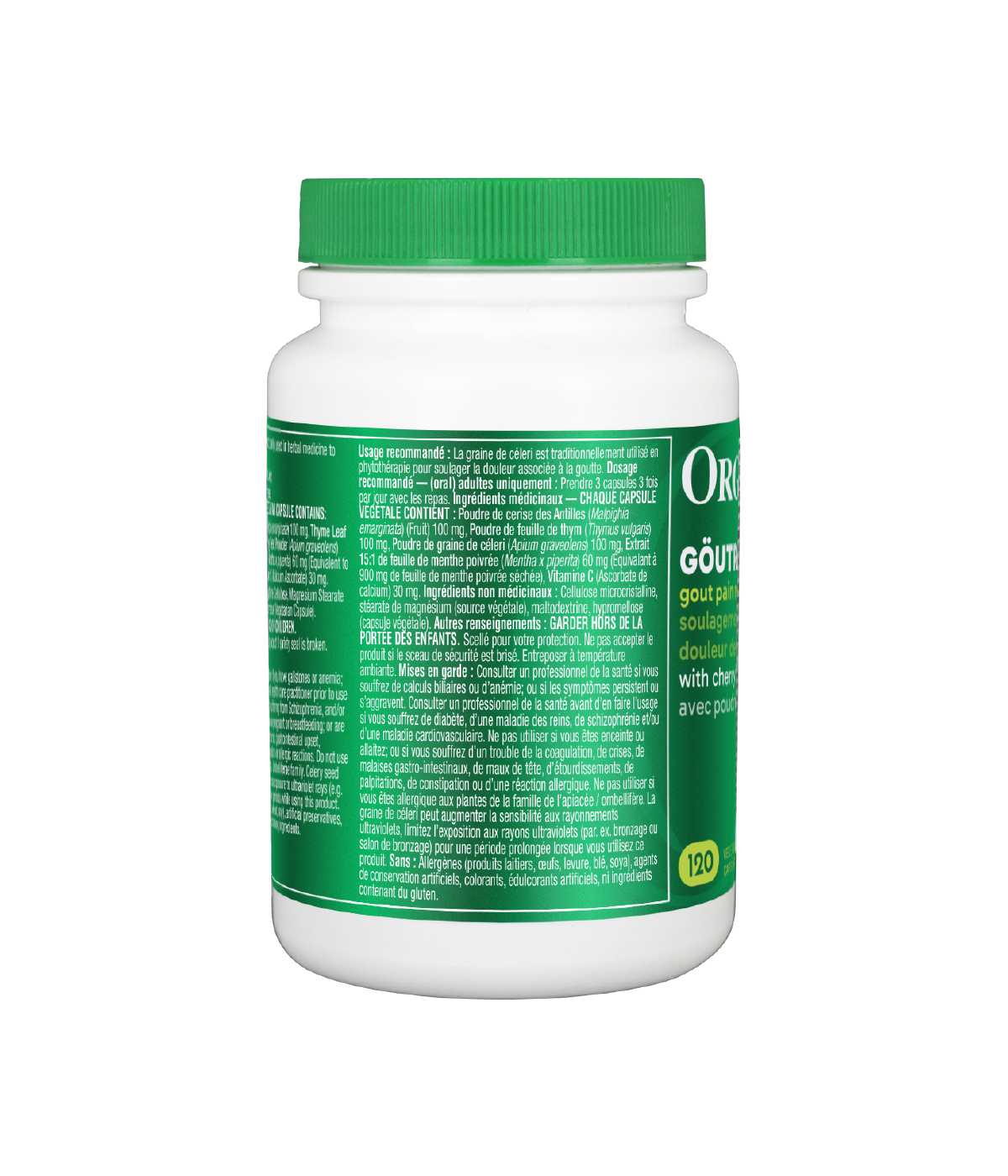




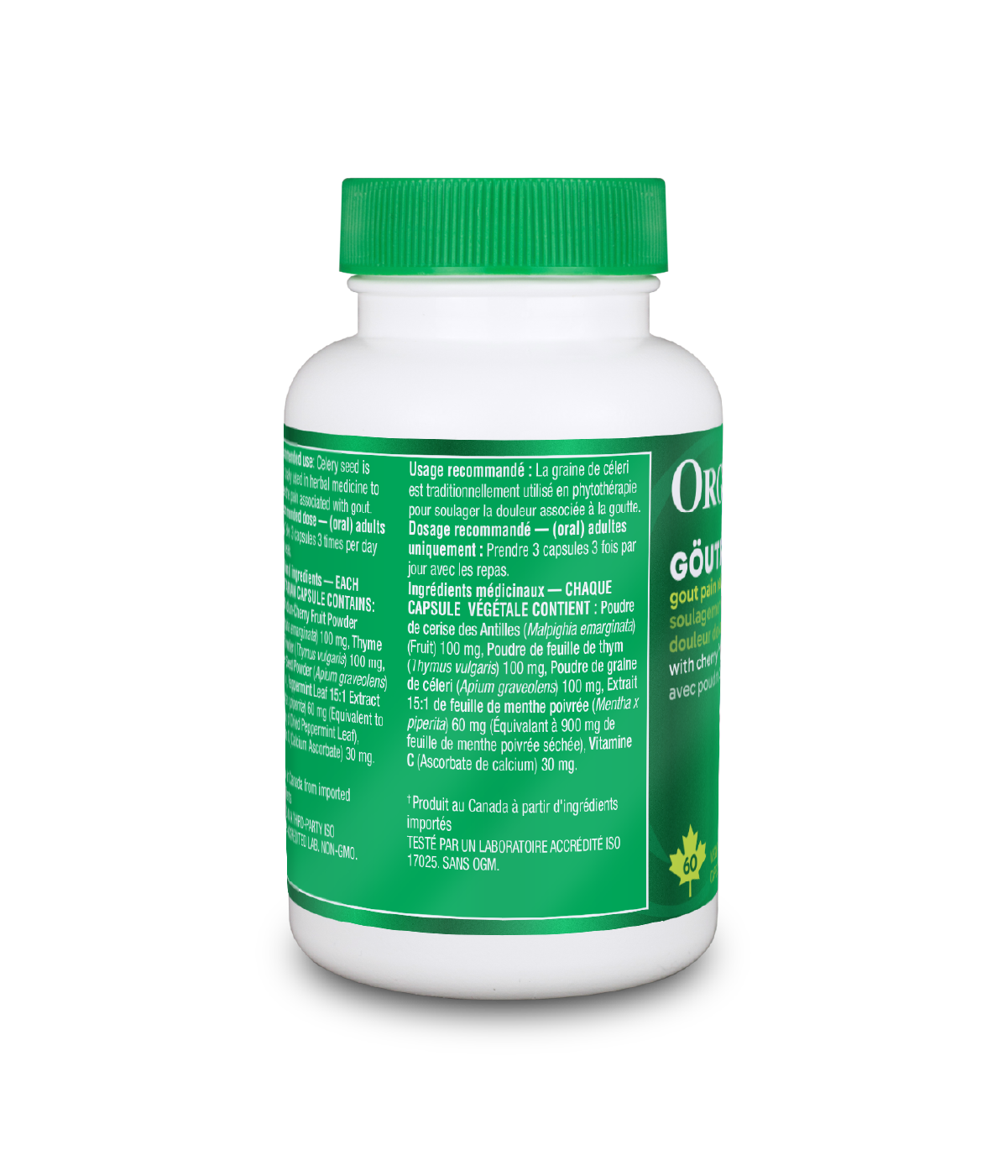










Supplement Facts










Ingredients & Nutrition
MEDICINAL INGREDIENTS - EACH VEGETARIAN CAPSULE CONTAINS: West Indian-Cherry Fruit Powder (Malpighia emarginata) 100 mg, Thyme Leaf Powder (Thymus vulgaris) 100 mg, Celery Seed Powder (Apium graveolens) 100 mg, Peppermint Leaf 15:1 Extract (Mentha piperita) 60 mg (Equivalent to 900 mg of Dried Peppermint Leaf), Vitamin C (Calcium Ascorbate) 30 mg.
NON-MEDICINAL INGREDIENTS: Microcrystalline Cellulose, Magnesium Stearate (Non-GMO Vegetable Source), Maltodextrin, Hypromellose / Pullulan (Vegetarian Capsule).
RECOMMENDED DOSE - (ORAL) ADULTS ONLY: Take 3 capsules 3 times per day with meals.
Cautions: Consult a health care practitioner if you have gallstones or anemia; or if symptoms persist or worsen. Consult a healthcare practitioner prior to use if you have diabetes or renal disorder, are suffering from Schizophrenia, and/or cardiovascular disease. Do not use if you are pregnant or breastfeeding; or are suffering from any bleeding disorders, seizures, gastrointestinal upset, headaches, dizziness, palpitations, constipation or allergic reactions. Do not use if you are allergic to plants in the Apiaceae / Umbelliferae family. Celery seed may increase UV light sensitivity, limit excess exposure to ultraviolet rays (e. g. sunbathing or tanning salons) for prolonged periods while using this product.
Is This Right for You?
Are you looking for a natural way to support healthy uric acid levels?
Do you want to reduce inflammation while also protecting joint tissue?
Are you looking for a non-pharmaceutical option to help manage uric acid naturally?
If you answered "yes" to any of the above, this product is right for you.

-
Helps lower uric acid levels
-
Capsule form for ease-of-use
Ingredients & Nutrition
Recommend For
Are you looking for a natural way to support healthy uric acid levels?
Do you want to reduce inflammation while also protecting joint tissue?
Are you looking for a non-pharmaceutical option to help manage uric acid naturally?
If you answered "yes" to any of the above, this product is right for you.
Gluten-Free
Non-GMO
Vegan Friendly
This blend offers uric acid balance and inflammation support to help relieve and prevent gout


The Full Scoop

-
Helps lower uric acid levels
-
Capsule form for ease-of-use
Designed to combat gout from all angles, Göutrin is a targeted blend that brings together some of the most researched, naturally supportive ingredients to help you manage uric acid. At its heart is cherry powder, which has been linked to a 35% reduced risk of gout attacks. It works by blocking urate reabsorption in the kidneys and encouraging its excretion, helping to lower overall uric acid levels. We've also included vitamin C, an antioxidant shown to reduce inflammation and support collagen production for healthy joints. Celery seed adds another dimension, acting as a natural diuretic to help flush excess uric acid, while thyme and peppermint contribute apigenin, a flavonoid known to inhibit xanthine oxidase (the enzyme that drives uric acid production). The result is an all-in-one capsule designed to target the root causes of gout flare-ups while also supporting joint comfort, mobility and overall wellness.
Ask Away
We’ve got the FAQs covered. But if you’re still stuck, we’re only a message away.
Get in TouchWho is most susceptible to gout?
Gout is most common in men, though women after menopause are also susceptible. Contributing factors include hypertension, cardiovascular disease and obesity. It can also have a genetic component, so if others in your family have gout, your chances may be higher.
What can contribute to a gout flare-up?
Flare-ups of gout can be triggered by stressful events, alcohol or drugs, or cold weather.
What about dietary choices?
Uric acid comes from the breakdown of a substance called purine. Purines naturally occur in the body, and are also found in some foods in our diet. These include meat, poultry, and seafood. Hereís a more specific list of high-purine foods:
Anchovies
Beef kidneys
Grains
Game meats
Gravy
Herring
Liver
Mackerel
Sardines
Scallops
Sweetbreads
Decreasing these foods in your diet may have a small impact on your uric acid levels. Though asparagus, dried beans and peas, and mushrooms are high in purines, research has shown they do not impact blood oxalic acid levels, therefore do not contribute to gout.
What can I do to decrease my chances of getting gout or having a recurrence?
If gout runs in your family, or to decrease your risks of occurence, drink plenty of water (a minimum of two litres), achieve an ideal body weight, and avoid alcohol. Alcohol interferes with the natural removal of uric acid through the kidneys. Switch to water to dilute wastes like uric acids being flushed through the kidneys and out via urine.
You'll Likely Also Love...
BioCell Collagen Capsules
Reduce joint stiffness and increase skin elasticity in one easy capsule
NAC (N-Acetyl-L-Cysteine) Capsules
The foundation of cellular defence
Liposomal Vitamin C
A highly absorbable form of Vitamin C to support immunity and more
Liposomal Glutathione
A hightly absorbable form of Glutathione antioxidant to protect your cells
Support Beyond Products
It’s time we talked gout, and about joint pain that affects many of us. Ever woken up with a stiff neck? How about right now, is your back stiff from sitting at your computer, currently reading this article? For the most part, we all experience joint pain to some degree due to athletic endeavours, long days at the office and the thing that we refer to as “kids.” But could you imagine having joint pain all the time? For those who suffer gout, you know this feeling all too well. Known as the “malady of kings,” gout is a form of arthritis that causes pain and inflammation within joints, leading to spikes of joint pain and significantly reduced mobility. What is Gout? Gout comes in acute and chronic attacks, causing sharp bouts of pain in joints (especially the big toe) or prolonged joint pain, respectively. Either way, gout can seriously hinder movement through joint pain and inflammation, making everyday activities near impossible. Accounting for approximately 5% of arthritis cases, statistics reveal that although gout is 3 times as prevalent in men than women and affects those primarily in their 40’s/50’s, gout can afflict anyone, of any age.1 In some cases, gout has been known to manifest even as early as after puberty. In addition, gout is more prevalent in those with kidney disease, since uric acid is processed in the kidneys. The Culprit? Dietary, genetic and environmental factors cause a spike in a chemical called uric acid, which is normally processed by the kidneys. If uric acid rises to excess levels then uric acid crystals begin to form around joints, resulting in the characteristic joint pain, inflammation and redness with joints. The Good, The Bad, And The Goutrin. Bad news: As a form of arthritis, gout has no known cure. Good news: There are options to effectively manage symptoms, and reduce gout flare up frequency and severity. Take Goutrin™, an organic blend of 5 potent antioxidants that have been proven to reduce uric acid within joints and reduce the frequency of gout flare-ups! Each vegetarian cap contains cherry, thyme, and celery seed powder, as well as vitamin C and peppermint extract, containing potent procyandins and phytochemicals that reduce the symptoms of redness, inflammation, and overall joint pain. The result? Better mobility, less joint pain, and a reduced severity of gout caused joint pain throughout the body – especially the knees, and peripheral joints in hands and feet. Combined with regular exercise, adequate water intake and a diet rich in healthy fats like omega-3 fatty acids and medium chain triglycerides, Goutrin™ helps to encourage healthy cartilage for joint cushioning, and reduces uric acid leading to gout pain. Reference 1 http://gout.readabout.org/2012/08/02/gout-statistics/
read moreStruggling with gout and wondering what to do about it? Get the answers to your questions and learn how to deal with gout naturally. If you’ve been diagnosed with gout, you’d probably do almost anything to avoid the excruciating joint pain that comes with an attack. Determining which natural therapies will most effectively manage your symptoms requires some education. You need to know why your joints feel like they’re screaming at you. So let’s talk about what’s happening on the inside and learn how to deal with gout. What is gout? Gout is a form of inflammatory arthritis. It occurs when uric acid crystallizes in the joints. It causes swelling, redness and pain that can last anywhere from a few days to a few weeks. The pain can be excruciating and downright debilitating during attacks. The big toe is a common place for gout pain to occur. But the pain can also be in other joints, such as the hands, wrists or ankles. If gout gets left untreated, it can lead to painless lumps of uric acid crystals that form under the skin and around the joints. These lumps are called tophi, and in some cases they may restrict movement. Where does uric acid come from? Uric acid happens when the body breaks down purines. We consume purines in the foods that we eat. In fact, purines are found in the cells of plants, animals and even humans. Some foods, like shellfish, or organ meats have higher levels of purines. A high level of uric acid in the blood can form needle-like crystals that build up in joints and soft tissues. Who’s at risk? Four times more men than women get gout. It commonly develops in men between the ages of 30 and 50. Women affected, typically develop symptoms after menopause. Gout affects up to 3% of the adult population in Canada. But, why me? There are a number of factors that can contribute to the development of gout. Genetics: Genes can affect the kidney’s ability to filter uric acid from the blood. If the kidneys can’t filter uric acid efficiently, levels can elevate in the body. Hyperuricemia: Hyperuricemia is a condition of elevated uric acid. It can be from an overproduction within in the body, or because the kidneys fail to efficiently process the uric acid. Not all individuals who experience hyperuricemia develop gout, but it does increase the risk. Diet: Certain foods high in purines can act as triggers for gout attacks. High purine foods include red meat, organ meats, shellfish, asparagus, mushrooms and alcohol. Okay, so to recap, we’ve established that gout is an inflammatory form of arthritis. It hurts, A LOT. We can blame uric acid. Which may be too high for a number of reasons. And now we’re ready to get it under control. So, what can I do to deal with gout? Maintaining a healthy diet and lifestyle can help to manage symptoms associated with gout. Here are some tips to help guide you in the right direction: Reduce your intake of purine-rich foods: That means foods like red meat, organ meats, some types of seafood like shellfish, lentils etc. Eat cherries: A diet rich in fruits and vegetables is overall beneficial, but studies actually show that eating cherries can reduce the occurrence of gout attacks. Eat an anti-inflammatory diet: An anti-inflammatory diet can help to reduce overall inflammation in the body. That includes pain associated with joint inflammation. Avoid or reduce alcohol intake: Some types of alcohol contain high amounts of purines. Beer especially. Sorry men. Drink plenty of water: Water is essential for maintaining kidney health. Why does this matter? Uric acid is filtered through the kidneys for excretion. Maintain a healthy weight: Being physically active is great for overall health, but it’s also great for healthy weight management. Overweight people are more likely to experience gout, while exercise can also help to reduce uric acid levels. Supplement right: Goutrin is a powerful combination of five effective ingredients. It works to reduce uric acid levels while relieving joint pain, stiffness and inflammation. Goutrin contains cherry fruit powder, peppermint, thyme, celery seed and vitamin C that helps to manage the symptoms associated with gout. It also provides antioxidants to reduce oxidative stress on joints. References: 1. http://articles.mercola.com/sites/articles/archive/2012/10/15/cherries-reduce-gout-attack-risks.aspx 2. http://www.mayoclinic.org/healthy-lifestyle/nutrition-and-healthy-eating/in-depth/gout-diet/art-20048524 3. http://blog.arthritis.org/gout/gout-flare-patient-story/#more-77 4. https://www.nlm.nih.gov/medlineplus/ency/article/003476.htm 5. Balch, Phyllis A. (2010) Prescription for Nutritional Healing. New York, New York: Penguin Group
read moreIt seems that everyone from celebrities, influencers, and your average Jenny-from-the-block has been taking you through their 12-step skincare regimen on Instagram. It was, and still is, very in vogue to care about your health and your glow. Organika is a pioneer in this field and has been coming out with on-trend products that are high quality and affordable for over 30 years. Two favourited and most relevant products in terms of skin care are Enhanced Collagen and Vitamin C products. Vitamin C and Collagen Benefits COLLAGEN’S ROLE IN SKIN CARE We’ve been hearing about collagen for the past couple of years now, and for good reason. Anyone in their mid-twenties will benefit from collagen. Why? Because collagen production starts to dwindle in our mid-to-late 20s, and we start losing 1% per year after that. By 40, the reduction accelerates dramatically. What does this mean? We begin seeing signs of aging such as wrinkles and dry skin. Additionally, our joints stiffen, we don’t have as much energy and take longer to recover from physical activity. Collagen is important not only for healthy skin, hair and nails, but also for reducing aches and pains in our muscles and joints and even gut health too. VITAMIN C’S ROLE IN SKIN CARE Most of us associate vitamin C with immunity, because this nutrient is a powerful antioxidant and boosts our immune systems. Ever since we discovered that scurvy was due to a deficiency in vitamin C, it’s been widely accepted that this vitamin supports the skin, and this knowledge is used as rationale for the addition of vitamin C to beauty products. Our skin, specifically our keratinocytes, contains high concentrations of vitamin C, which aid in collagen production, wound healing, minimizing scar formation and assisting in antioxidant protection against UV damage, all of which ameliorates signs of aging skin. A diet rich in fruits and vegetables is vital for maintaining healthy skin and collagen production, due to the vitamin C concentration. Vitamin C has such a wide range of appreciable benefits that supplementation should be part of everyone’s diet. The RDA for Vitamin C is no more than 2000 mg a day, with a minimum of 75 mg, though experts will argue this is too low to have any beneficial effects. Can I Use Collagen and Vitamin C Together? Yes! And you should! Collagen and vitamin C supplements work better together. Why? Because vitamin C is a nutrient that can help boost your body's natural production of collagen (aka a collagen builder). Taking collagen and vitamin C together will likely boost your skin health more than taking either on their own. Note: You don’t need to consume vitamin C at the same time you take your collagen supplement, they don't need to be taken together to get the full benefits of collagen. Vitamin C and Collagen Synthesis If you type in ‘Vitamin C and Collagen’ in PubMed and you’ll get over 1900 results.There has been ample research into the synergy of taking these two compounds together. In one study, it’s been shown that vitamin C increased collagen deposits, showing that it plays a critical role preventing the auto-inactivation of certain collagen enzymes that are key in producing collagen.¹ Another study has shown that vitamin C is important for wound healing because of its essential role in collagen synthesis, and that vitamin C enhanced the formation of collagenous proteins.² Other studies have linked vitamin C to collagen production, skin hydration, wound healing, wrinkle reduction, and improved inflammatory skin conditions.³ Note: Vitamin C is an amazing nutrient for aging gracefully. Even though you don’t have to take collagen and vitamin C together, it’s important to get enough of each. Intakes can increase with age. Choosing a Vitamin C product When buying any supplement, including collagen and vitamin C, you want to make sure that it is high quality. Check the ingredient list: your collagen should be a clean, single-ingredient formula, sourced from grass-fed pasture raised cattle, free from all hormones, antibiotics, GMOs and gluten. In terms of vitamin C, there are lots of options: Instant C – vitamin C in convenient tablets that flavour your water Instant C, D, Zinc Immunity Effervescent – combining additional immune support nutrients Liposomal Vitamin C – more potent and higher bioavailable vitamin C References: 1. Effect of vitamin C and its derivatives on collagen synthesis and cross-linking by normal human fibroblasts - PubMed (nih.gov) Boyera N, Galey I, Bernard BA. Effect of vitamin C and its derivatives on collagen synthesis and cross-linking by normal human fibroblasts. Int J Cosmet Sci. 1998 Jun;20(3):151-8. 2. Enhanced production of mineralized nodules and collagenous proteins in vitro by calcium ascorbate supplemented with vitamin C metabolites - PubMed (nih.gov) Rowe DJ, Ko S, Tom XM, Silverstein SJ, Richards DW. Enhanced production of mineralized nodules and collagenous proteins in vitro by calcium ascorbate supplemented with vitamin C metabolites. J Periodontol. 1999 Sep;70(9):992-9. 3. The Roles of Vitamin C in Skin Health - PMC (nih.gov) Pullar JM, Carr AC, Vissers MCM. The Roles of Vitamin C in Skin Health. Nutrients. 2017 Aug 12;9(8):866. This article has been fact-checked and reviewed by RHNs.
read more





